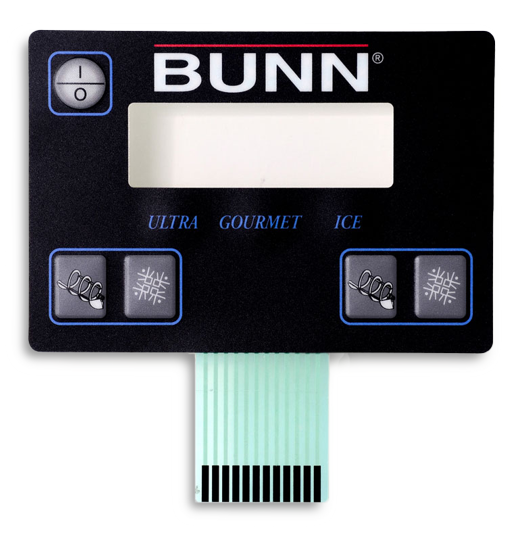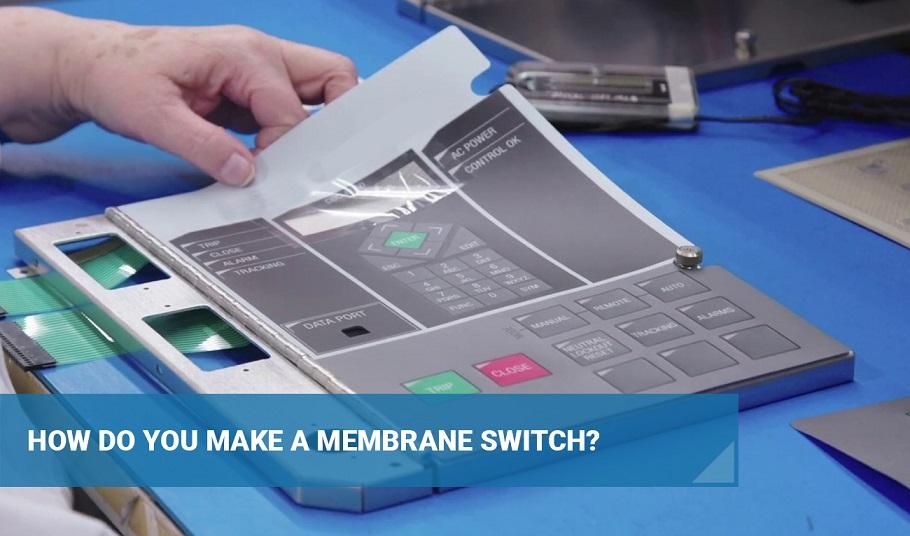Checking Out the Production Refine of Membrane Switch for Numerous Industries
The production procedure of Membrane switches is an intricate endeavor that demands precision and focus to detail. From picking ideal products to implementing extensive top quality control steps, each action plays an essential role in making sure performance. Different industries, consisting of automotive and clinical, rely upon these elements for their unique applications. Understanding the details of this process exposes considerable insights right into exactly how these switches are produced and their influence across varied fields.
Understanding Membrane Switches Over: A Review

Key Materials Used in Membrane Switch Manufacturing
In Membrane button manufacturing, the choice of vital products greatly affects performance and longevity. Conductive materials, adhesives, and finishings play important functions, while substrate option influences general efficiency and reliability. Comprehending these components is necessary for maximizing the design and manufacturing of Membrane switches.
Conductive Materials Introduction
Conductive materials play an essential role in the performance of Membrane buttons, making certain reliable electric links within the gadget. Frequently utilized products include silver, copper, and carbon-based inks, each offering distinctive advantages. Silver is favored for its high conductivity and durability, making it perfect for applications requiring durable efficiency. Copper, while somewhat less conductive than silver, is an economical choice usually used in published circuits. Carbon-based inks provide a versatile choice, ideal for applications where versatility and reduced expenses are focused on, although they have lower conductivity compared to metal alternatives. The option of conductive materials directly affects the overall integrity, lifespan, and performance of the Membrane switch, making it an essential factor to consider in the manufacturing procedure.
Adhesives and Coatings
Adhesives and coverings are necessary elements in the manufacturing of Membrane switches, supplying essential bonding and safety homes. These products ensure that different layers of the switch, consisting of graphic overlays and wiring, adhere firmly to each other, improving sturdiness and functionality. Typically utilized adhesives include pressure-sensitive adhesives (PSAs) and epoxy-based formulations, which provide solid attachment and resilience. Coatings, such as polyurethane or acrylic, serve to shield against environmental aspects, including wetness, abrasion, and chemicals. Furthermore, finishes can improve tactile responses and visual charm, contributing to the overall user experience. The choice of suitable adhesives and layers is vital for maximizing performance and durability in varied applications across numerous industries, making sure that Membrane changes fulfill details functional demands.
Substrate Selection Elements
Substrate option plays an important duty in the manufacturing of Membrane buttons, as it greatly affects their general performance and sturdiness. Secret materials such as polyester, polycarbonate, and adaptable printed circuit boards (FPCBs) are commonly made use of for their unique residential properties. Polyester is preferred for its cost-effectiveness and resistance to abrasion, making it suitable for applications with high wear. Polycarbonate offers exceptional quality and effect resistance, perfect for settings requiring high exposure. FPCBs supply boosted flexibility and are typically made use of in complex layouts. The selection of substratum likewise affects aspects like thermal stability, chemical resistance, and simplicity of printing. Ultimately, picking the appropriate substrate is vital for guaranteeing the capability and longevity of Membrane switches throughout numerous markets.
The Layout Refine of Membrane Switches
The style procedure of Membrane buttons is a crucial stage that greatly affects the capability and appearances of the final item - membrane switch manufacturer. It starts with specifying the certain requirements of the application, consisting of dimensions, switch format, and tactile responses choices. Designers need to take into consideration individual communication, ensuring that the switch is instinctive and accessible.Next, materials are chosen based on durability, versatility, and ecological resistance. The integration of graphics and branding aspects is additionally important, as it boosts aesthetic allure and interaction. Prototyping permits iterative screening, making it possible for changes based upon user responses and efficiency evaluations.Additionally, the layout has to account for the electric parts, such as circuits and ports, making sure integrity and simplicity of usage. Inevitably, an effective design integrates capability, looks, and customer experience, leading the way for reliable production and resilient performance in various markets
Printing Methods for Membrane Switches
The printing techniques made use of in Membrane button production play an important function in establishing the last product's top quality and capability. Screen printing uses benefits such as longevity and lively shade application, while digital printing advancements provide adaptability and accuracy in style. Understanding these approaches can substantially affect the general efficiency of Membrane buttons in numerous applications.
Screen Printing Advantages
Countless advantages make screen printing a recommended technique for producing Membrane buttons. This method allows for high-grade, dynamic colors and detailed designs, which are important for interface applications. Screen printing is specifically reliable for using thick ink layers, boosting durability and tactile responses. On top of that, it uses excellent attachment to different substrates, making sure long life in demanding environments. The process is cost-effective for large manufacturing runs, as it reduces configuration time and waste. Moreover, display printing sustains a large range of inks, consisting of specialty and UV-curable options, enabling versatility in design. Its capacity to produce constant results throughout numerous units makes it a trusted option for makers intending for top quality and effectiveness in Membrane button production.
Digital Printing Innovations

Developments in electronic printing technology are transforming the manufacturing of Membrane buttons, supplying suppliers ingenious remedies that boost design flexibility and performance. Digital printing permits high-resolution graphics and complex designs, making it possible for custom-made branding and functionality without the limitations of standard techniques. This technique decreases setup times and prices, assisting in much shorter production runs and very little waste, making it optimal for organizations with varying needs. Additionally, advancements in ink formulas provide better resilience and adhesion, making sure long life in numerous environments. As markets significantly look for complex and personalized layouts, digital printing stands out as an important method, establishing a new requirement in Membrane button manufacturing. The integration of these innovations settings suppliers to fulfill progressing market needs successfully.
Setting up and Layering of Membrane Switch Parts
Careful assembly and layering of Membrane switch parts are important to assuring capability and durability. This procedure starts with the precise alignment of various layers, including the graphic overlay, glue, circuit layer, and backing product. Each component needs to be meticulously positioned to keep electric stability and customer interface responsiveness.During assembly, conductive traces are put on the circuit layer, normally made from materials like polyester try this website or polycarbonate. This layer is essential, as it beams when stress is applied. The sticky utilized for bonding these layers is also chosen for its capacity to endure environmental stresses while maintaining a safe bond.Heat and pressure are typically used during the assembly procedure to identify that the layers stick effectively without endangering the capability of the switch. Lastly, attention is given to the side securing to protect against dampness and pollutants, safeguarding the long life of the Membrane switch in different commercial applications.
Quality Control Procedures in Membrane Switch Production
Quality control procedures play a crucial duty in making sure the dependability and performance of Membrane changes adhering to the setting up and layering of their elements. In the manufacturing procedure, numerous vital evaluations are carried out to support high quality requirements. These consist of aesthetic evaluations for issues in printing and adhesive application, along with functional examinations to confirm the responsiveness of each switch.Additionally, environmental testing is carried out to analyze the buttons' longevity versus temperature fluctuations and moisture exposure. Manufacturers usually carry out statistical procedure control (copyright) strategies to check manufacturing uniformity, enabling very early detection of anomalies.Furthermore, traceability systems are developed to track products and parts, guaranteeing responsibility and facilitating remembers if required. Calibration of tools and adherence to market standards are likewise vital to keeping product stability. Jointly, these top quality control measures secure the efficiency of Membrane switches over across numerous applications, ultimately boosting customer fulfillment.
Applications of Membrane Switches Over Across Different Industries
Membrane buttons are made use of throughout a varied range of sectors, showcasing their convenience and versatility. In the medical field, they supply trusted and water-proof user interfaces for devices such as analysis equipment and mixture pumps, guaranteeing health and convenience of usage. The auto industry employs Membrane switches for control panel controls, enabling smooth communication in between the driver and vehicle systems.In customer electronic devices, these switches are discovered in home appliances and handheld gadgets, offering a sleek, modern-day aesthetic while improving capability. Industrial applications also utilize Membrane switches over for machinery control board, where durability and resistance to rough problems are essential.Furthermore, the aerospace and defense sectors use Membrane buttons for cabin instrumentation and communication systems, prioritizing integrity and efficiency under extreme problems. Overall, Membrane switches play a critical function in improving the customer linked here experience and functional effectiveness across numerous domain names.
Frequently Asked Questions
The length of time Does It Take to Produce a Membrane Layer Switch?
The production time for a membrane layer button generally ranges from a couple of days to numerous weeks - membrane switch manufacturer. Factors affecting this period consist of layout complexity, product schedule, and manufacturing volume, all impacting the overall timeline markedly
What Is the Typical Life Expectancy of a Membrane Switch?
The normal life-span of a membrane layer button generally varies from 1 to 5 million actuations, depending on aspects such as material top quality, ecological problems, and use regularity, greatly impacting durability and total performance.
Can Membrane Switches Be Customized for Specific Applications?
Membrane buttons can without a doubt be personalized for specific applications. Their style adaptability enables changes in dimension, shape, colors, and graphics, making certain compatibility with unique requirements throughout numerous markets and boosting performance and customer experience.

Are Membrane Switches Environmentally Pleasant?
The environmental impact of Membrane switches over varies. Some materials made use of might not be green, while advancements in making procedures are significantly concentrating Website on sustainability, intending to reduce waste and promote recyclable parts in their production.
What Are the Typical Failure Settings of Membrane Switches?
Common failing modes of Membrane buttons consist of delamination, glue failure, damage from use, moisture ingress, and electrical failings. These issues can significantly influence functionality, efficiency, and life-span in different applications across various markets. Membrane buttons can be tailored to fit certain design requirements, such as performance, size, and shape, making them very adaptable.The construction typically involves numerous layers, including a visuals overlay, glue, and a circuit layer, which function with each other to create a smooth customer experience. In Membrane switch manufacturing, the choice of crucial materials considerably affects performance and sturdiness. The automotive industry employs Membrane switches for dashboard controls, enabling smooth interaction in between the driver and car systems.In customer electronic devices, these buttons are discovered in appliances and portable devices, providing a streamlined, modern-day aesthetic while improving functionality. Industrial applications likewise leverage Membrane switches over for machinery control panels, where longevity and resistance to harsh conditions are essential.Furthermore, the aerospace and protection fields use Membrane switches for cockpit instrumentation and interaction systems, prioritizing dependability and efficiency under severe conditions. Membrane switches can undoubtedly be customized for particular applications.